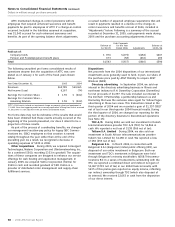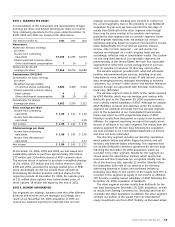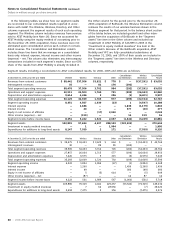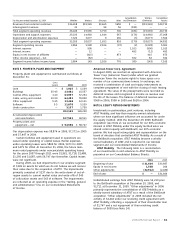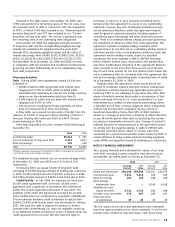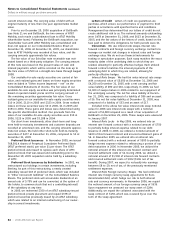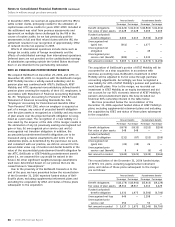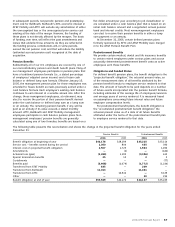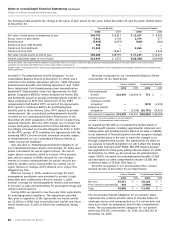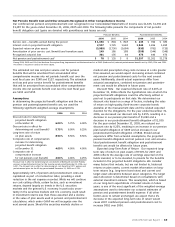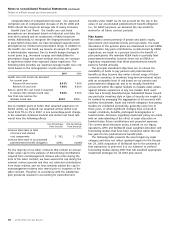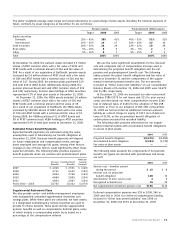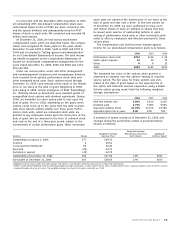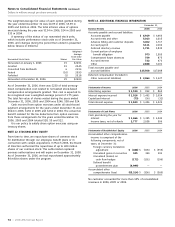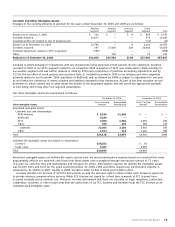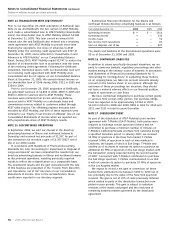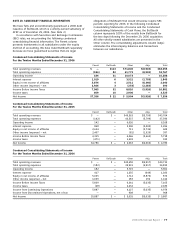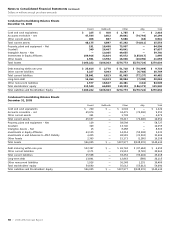AT&T Wireless 2006 Annual Report Download - page 70
Download and view the complete annual report
Please find page 70 of the 2006 AT&T Wireless annual report below. You can navigate through the pages in the report by either clicking on the pages listed below, or by using the keyword search tool below to find specific information within the annual report.
68 : :
2006 AT&T Annual Report
Notes to Consolidated Financial Statements (continued)
Dollars in millions except per share amounts
The following table presents the change in the value of plan assets for the years ended December 31 and the plans’ funded status
at December 31:
Pension Benefits Postretirement Benefits
2006 2005 2006 2005
Fair value of plan assets at beginning of year $48,755 $29,813 $ 11,417 $ 8,692
Actual return on plan assets 6,311 2,704 1,379 677
Benefits paid1 (3,958) (2,679) (920) (381)
Transferred from AT&T Mobility 548 — — —
Transferred from BellSouth 17,628 — 5,269 —
Transferred from ATTC — 18,917 — 2,429
Fair value of plan assets at end of year $69,284 $48,755 $ 17,145 $ 11,417
Funded (unfunded) status at end of year2 $13,335 $ 2,579 $(26,992) $(23,808)
1 At our discretion, certain postretirement benefits are paid from AT&T cash accounts and do not reduce Voluntary Employee Beneficiary Association (VEBA) assets. Future benefit
payments may be made from VEBA trusts and thus reduce those asset balances.
2 Funded status is not indicative of our ability to pay ongoing pension benefits nor of our obligation to fund retirement trusts. Required pension funding is determined in accordance with
ERISA regulations.
Amounts recognized on our Consolidated Balance Sheets
at December 31 are listed below:
Pension Benefits Postretirement Benefits
2006 2005 2006 2005
Postemployment
benefit $13,335 $12,699 $ 772 $ —
Current portion
employee benefit
obligation1 — — (973) (1,505)
Employee benefit
obligation2 — (1,548) (26,791) (14,953)
Net amount recognized $13,335 $11,151 $(26,992) $(16,458)
1Included in “Accounts payable and accrued liabilities.”
2Included in “Postemployment benefit obligation.”
As required by FAS 158, we recognized the funded status of
defined benefit pension, including supplemental retirement and
savings plans, and postemployment plans as an asset or liability
in our statement of financial position and will recognize changes
in that funded status in the year in which the changes occur
through comprehensive income. This standard has no effect on
our expense or benefit recognition nor will it affect the funding
requirements imposed under ERISA. FAS 158 requires prospec-
tive application for fiscal years ending after December 15, 2006.
At December 31, 2006, we decreased our net postretirement
assets $4,891, increased our postemployment benefits $3,459
and decreased our other comprehensive income $4,786 (net
of deferred taxes of $3,564). (See Note 1)
Amounts recognized in our accumulated other compre-
hensive income at December 31 are listed below:
Pension Benefits Postretirement Benefits
2006 2005 2006 2005
Net loss $4,271 $ — $ 6,124 $ —
Prior service cost (benefit) 624 — (2,669) —
Total $4,895 $ — $ 3,455 $ —
The accumulated benefit obligation for our pension plans
represents the actuarial present value of benefits based on
employee service and compensation as of a certain date and
does not include an assumption about future compensation
levels. The accumulated benefit obligation for our pension
plans was $53,662 at December 31, 2006, and $44,139 at
December 31, 2005.
Included in “Postemployment benefit obligation” on our
Consolidated Balance Sheets at December 31, 2004, was a
reduction in the liability associated with the “1983 Unfunded
Postretirement Benefits Cost Sharing Agreement” and “1983
Force Adjustment Cost-Reimbursement and Indemnification
Agreement” (Agreements). Under the Agreements, the Bell
System Companies (RBOCs) (which included the former SBC
and BellSouth) agreed to provide postemployment benefits to
those employees of ATTC who retired prior to the 1983
reorganization that divided ATTC. As part of the Agreements,
ATTC agreed to reimburse RBOCs for postemployment
benefits paid to these retirees. Since ATTC agreed to provide
reimbursement, the accumulated postemployment benefits
recorded on our Consolidated Balance Sheets prior to the
November 18, 2005 acquisition of ATTC did not include these
expected payments. After the ATTC merger, we no longer will
receive third-party reimbursement for these liabilities and
accordingly increased our benefit obligation by $234 in 2005
for the ATTC merger. ATTC maintains the Agreements with the
remaining RBOCs and we include estimated amounts subject
to reimbursement on our Consolidated Balance Sheets as
“Other noncurrent liabilities.”
Also included in “Postemployment benefit obligation” on
our Consolidated Balance Sheets at December 31, 2004, were
phone concessions for out-of-region retirees. The out-of-
region phone concession, which is not part of the pension
plan and not subject to ERISA, allowed for out-of-region
retirees to receive reimbursements for phone services pro-
vided by another carrier. During 2005, we notified out-of-
region retirees of changes which allowed us to reduce this
obligation by $96.
Effective January 1, 2006, medical coverage for most
management participants was amended to provide a high-
deductible plan. Additionally, effective January 1, 2005,
medical coverage for nonmanagement retirees was amended
to increase co-pays and deductibles for prescription drugs and
certain medical services.
During 2004, we agreed to new five-year labor agreements
for nonmanagement employees. The agreements provided
that, prior to expiration of the agreement, we would contrib-
ute $2,000 to a VEBA trust to partially fund current and future
retiree health care, $1,000 of which was contributed during
2004.


